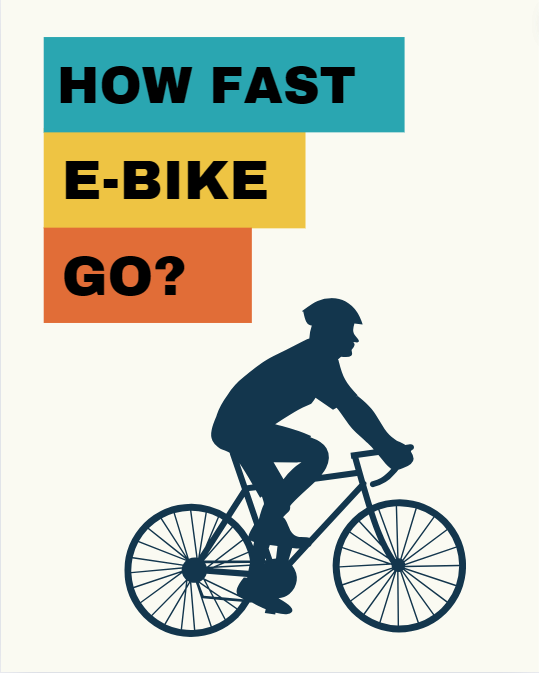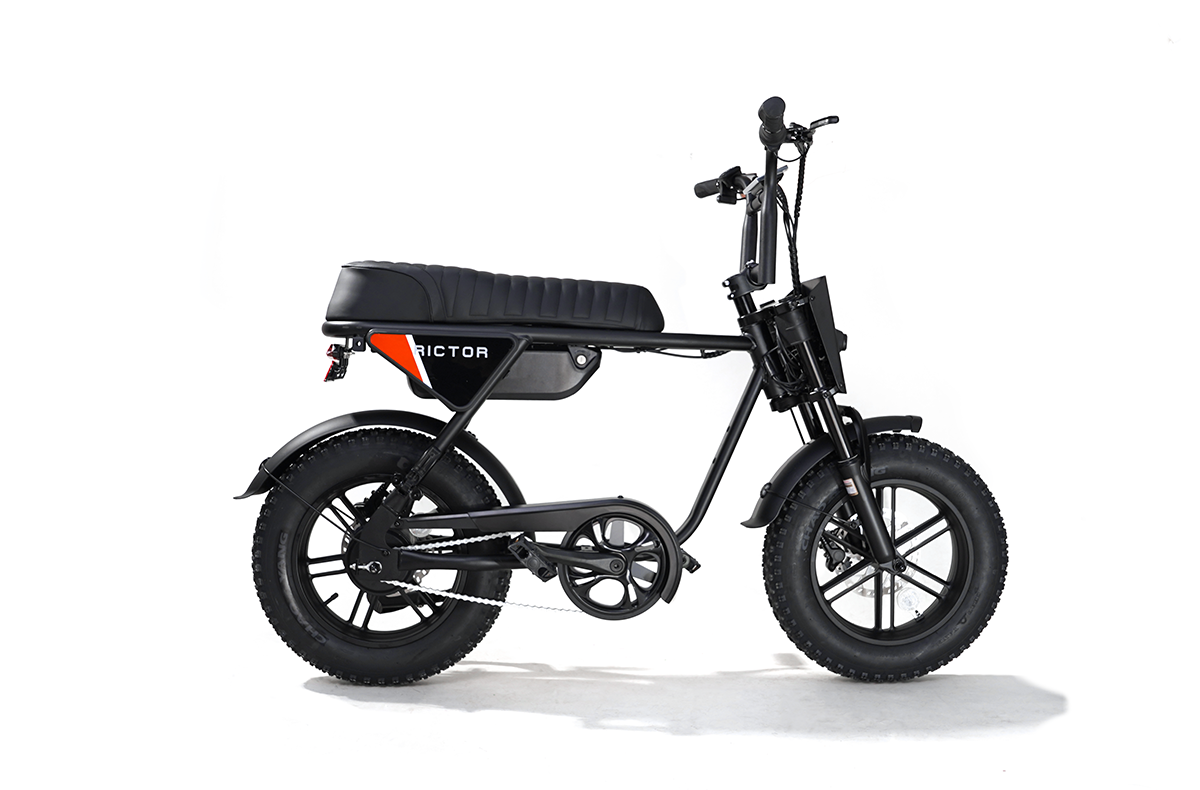
Beyond the Basics | How Fast Can Your Electric Bike Really Go?
"How fast can an electric bike go?" The answer isn’t as straightforward as you might think. There are several factors at play, from the type of motor and battery your bike has to how much you weigh and the kind of terrain you’re riding on. Even things like wind resistance and tire type can make a difference. So, let’s dive deeper into what really determines the speed of an electric bike and see how fast you can realistically expect to go.
What is the Top Speed of an Electric Bike
In the U.S., most electric bikes are legally limited to a top speed of 20 to 28 mph when using motor assistance.
This means that once your bike hits 20 mph (for Class 1 and Class 2 e-bikes) or 28 mph (for Class 3 e-bikes), the motor will stop providing assistance. After that, it’s all up to your legs if you want to go faster.
With the Rictor K1 electric bike, you can enjoy a max speed of 20 mph in electric mode and up to 28 mph with pedal assist, covering up to 35 miles on electric mode and over 70 miles with pedal assist.
The motor’s wattage is a big factor in how quickly you can reach that top speed.
A 750W motor will get you up to speed much faster than a 250W motor, especially if you’re on flat terrain.
That’s not the whole story. The bike’s weight, your weight, and even the cargo you’re carrying can all affect how fast you can go.
A lighter bike with a lighter rider will accelerate quicker and maintain speed more easily than a heavier setup.
Terrain also plays a big role. Riding on a smooth, flat road allows you to maintain your top speed with minimal effort, while riding uphill or on rough surfaces can slow you down significantly.
Even the weather can be a factor; a strong headwind can make it harder to maintain speed, while a tailwind can give you a nice boost.
| Motor Power (W) | Speed on Flat Terrain (mph) | Speed on Hilly Terrain (mph) |
|---|---|---|
| 250W | 20 | 15 |
| 350W | 22 | 17 |
| 500W | 24 | 20 |
| 750W | 28 | 24 |
| 1000W | 32 | 28 |
| 1500W | 36 | 32 |
| 2000W | 40 | 36 |
| 2500W | 44 | 40 |
| 3000W | 48 | 44 |
| 3500W | 52 | 48 |
How Different Motor Types Affect E-bike Speed
When it comes to e-bike motors, the type of motor can significantly impact your speed and overall riding experience.
There are two main types of motors: direct-drive and geared.
Direct drive motors are the heavyweights of the e-bike world. They’re typically larger and heavier, but they provide a smooth and quiet ride, especially at higher speeds.
Because of their design, they’re more efficient at maintaining speed on flat terrain, making them ideal for riders who want a steady, fast ride without much fuss.
Direct-drive motors can struggle with hills because they lack the torque needed for quick acceleration on inclines.
Geared motors, on the other hand, are all about torque. They’re smaller and lighter, which makes them better for quick acceleration and climbing hills.
If your daily ride involves a lot of stop-and-go traffic or hilly terrain, a geared motor can make your ride much more enjoyable.
They can be a bit noisier and might not maintain high speeds as efficiently as direct-drive motors on flat roads.
Choosing the right motor type depends largely on your riding conditions and what you value more: smooth, high-speed cruising, or quick, responsive power for varied terrain.
How Battery Size Affects Your Bike's Speed
Your e-bike’s battery is like its fuel tank, and just like in a car, the size of that tank matters—especially if you want to keep going fast for longer periods.
Battery capacity is measured in watt-hours (Wh), and it determines how much energy your bike has stored to power the motor.
A larger battery, say 500Wh or more, allows you to ride at higher speeds for longer distances.
If you’re cruising at 28 mph on a flat road, a 500Wh battery will last significantly longer than a 250Wh battery.
This is crucial in the U.S., where distances between destinations can be long, especially if you’re planning to use your e-bike for commuting or long weekend rides.
However, it’s important to remember that riding at top speeds drains your battery faster.
The more power you demand from the motor, the quicker the battery depletes.
This means if you’re planning a long ride and want to maintain high speeds, you’ll need to either bring along an extra battery or be prepared to drop your speed to conserve energy.
Temperature can also affect battery performance. In colder weather, batteries tend to drain faster, meaning your high-speed rides might be shorter in the winter months.
On the flip side, extremely hot temperatures can also reduce battery efficiency, so it’s always good to plan your rides with the weather in mind.

Can an Electric Bike Go 60 mph
The idea of an electric bike reaching 60 mph is thrilling, but for most riders, it’s not realistic—or legal.
Standard e-bikes in the U.S. are limited to 28 mph with motor assistance, and going beyond that requires a whole different setup.
There are some custom or high-performance e-bikes that can theoretically reach higher speeds, but these are far from the norm.
For example, there are electric motorcycles or high-powered e-bikes that can exceed 60 mph, but these are classified differently from standard e-bikes.
They might require special licensing, registration, and insurance, much like a traditional motorcycle.
These high speeds also raise significant safety concerns.
At 60 mph, you’re moving fast enough that a small mistake or unexpected obstacle can have serious consequences.
E-bike frames, tires, and brakes are generally not designed for such high speeds, making it risky to push them beyond their intended limits.
Additionally, riding at such high speeds on an e-bike can drastically reduce the battery life.
The faster you go, the more power the motor uses, meaning your battery could drain in a matter of minutes rather than hours.
For these reasons, while 60 mph e-bikes do exist, they’re not practical for everyday use, especially within the legal frameworks of most U.S. states.
E-bike Speed in Different Riding Modes
Most modern e-bikes come with multiple riding modes, like Eco, Sport, and Turbo, each designed to give you different levels of power and speed.
Eco mode is all about efficiency. It uses the least amount of power, helping you conserve battery life while offering just enough assistance to make your ride easier.
If you’re on a long ride and want to make sure your battery lasts, Eco mode is the way to go.
You won’t be breaking any speed records, but you’ll get where you’re going with plenty of power to spare.
Sport mode offers a balance between speed and efficiency.
It gives you a bit more power than Eco mode, allowing you to go faster while still conserving some battery life.
This mode is great for everyday riding, where you need a bit more speed but don’t want to drain your battery too quickly.
Turbo mode is where the fun really starts.
It gives you maximum power from the motor, letting you reach your bike’s top speed quickly and maintain it for as long as your battery allows.
This mode is perfect for short, fast rides or when you’re in a hurry.
However, Turbo mode will drain your battery the fastest, so it’s best used sparingly if you’re planning a longer trip.
If you’re commuting to work and need to get there quickly, Turbo mode might be your best bet. But if you’re out for a long, leisurely ride, switching to Eco mode can help ensure you don’t run out of power before you make it back home.
How Fast is an Electric Bike Allowed to Go
In the U.S., e-bike speed limits are set by federal law to ensure safety and consistency across different states. These laws classify e-bikes into three categories, each with its own speed restrictions:
-
Class 1 e-bikes are pedal-assist only, meaning the motor provides assistance only when you’re pedaling. The maximum speed for these bikes is 20 mph. Once you hit that speed, the motor stops helping, and any additional speed is all you.
-
Class 2 e-bikes also have a top speed of 20 mph, but they come with a throttle that allows you to accelerate without pedaling. These bikes offer more flexibility in how you ride, making them popular for urban commuting.
-
Class 3 e-bikes are the fastest of the bunch, with a top speed of 28 mph. These are also pedal-assist only, and they’re often used by riders who want a bit more speed, whether for commuting or recreational riding. However, because of their higher speed, Class 3 e-bikes are restricted from certain bike paths and trails, so it’s important to check local regulations before you ride.
These classifications help keep e-bike riders safe while ensuring that e-bikes can be used on roads and bike paths without creating hazards for other riders or pedestrians.
If you exceed these speeds, your e-bike could be classified as a moped or motorcycle, requiring additional registration, licensing, and insurance.

Legal and Insurance Implications of High-Speed E-bikes
Riding a high-speed e-bike might sound like fun, but it comes with its own set of legal and insurance challenges.
In the U.S., the legal classification of an e-bike depends largely on its top speed and how it’s powered.
If your e-bike can exceed the standard 28 mph limit, it might be classified as a moped or even a motorcycle in some states.
This reclassification could mean you need to register your bike with the DMV, get a special license, and carry specific insurance.
Insurance is another consideration.
Many standard bike insurance policies don’t cover e-bikes, especially those that can go faster than 28 mph.
If you’re riding a high-speed e-bike, it’s crucial to check with your insurance provider to see what’s covered.
You might need a separate policy that includes liability coverage in case of an accident, as well as protection for theft or damage to your bike.
Moreover, riding a faster e-bike on public roads can expose you to greater legal risks.
If you’re involved in an accident while exceeding the speed limit, you could be held liable for any damages or injuries, even if the accident wasn’t entirely your fault.
This makes understanding the legal and insurance implications of riding a high-speed e-bike critical to protecting yourself on the road.
Why Are Electric Bicycles Limited to 28 mph
You might wonder why e-bikes are often capped at 28 mph. The reasoning is all about safety and regulation.
At speeds above 28 mph, the risk of accidents increases significantly.
Most e-bikes are designed with this speed limit in mind, meaning the brakes, tires, and overall frame strength are optimized for safe riding at these speeds.
Pushing beyond this limit could put unnecessary strain on these components, leading to potential failures and dangerous situations.
Additionally, keeping e-bikes limited to 28 mph helps ensure they remain classified as bicycles rather than motorcycles.
This classification allows them to be ridden on bike paths and lanes without the need for additional licensing or insurance, making them more accessible and convenient for the average rider.
There’s also a regulatory aspect to consider.
By limiting e-bikes to 28 mph, authorities can more easily enforce traffic laws and ensure that e-bike riders share the road safely with cars, motorcycles, and traditional bicycles.
So, while it might be tempting to push the limits, it’s important to remember that these restrictions are in place for good reasons.
E-bike Speed vs. Traditional Bikes and Motorcycles
When you compare e-bikes to traditional bicycles, the speed difference is immediately noticeable.
A typical cyclist on a traditional bike might average 12-15 mph on flat terrain, depending on their fitness level and the type of bike they’re riding.
E-bikes, with motor assistance, easily double that speed, making them an attractive option for commuters who want to get to their destination faster without arriving drenched in sweat.
When compared to motorcycles, e-bikes are still much slower. Motorcycles are built for high speeds and can easily exceed 60 mph, which makes them suitable for highway travel and long-distance commuting.
However, this also means they require more maintenance, a motorcycle license, and insurance—factors that make them less convenient than e-bikes for short, urban commutes.
E-bikes offer a sweet spot for many riders in the U.S. They’re fast enough to make commuting efficient and enjoyable, but not so fast that they require special licensing or present significant safety risks.
This balance makes e-bikes an excellent choice for city dwellers and suburbanites alike, offering a practical, eco-friendly, and fun way to get around.
Conclusion
Electric bikes are flipping the script on personal transportation,
offering an efficient and fun way to get around, especially in urban areas. Speed is important, but it’s just one part of what makes an e-bike great. Consider factors like motor power, battery life, and riding modes to find the right fit for your lifestyle.
In the U.S., following speed limits keeps you safe and compliant with the law. Whether you're commuting, exploring new trails, or just cruising, the Rictor K1 electric bike delivers both speed and a smooth ride. Ready to elevate your riding experience? Explore what Rictor K1 can do for you today!
FAQs
How does the terrain affect the battery life of an e-bike?
Riding on hilly or rough terrain typically drains the battery faster because the motor has to work harder to maintain speed. On flat terrain, your e-bike uses less energy, which extends the battery life. If you often ride on challenging terrains, consider an e-bike with a larger battery capacity.
Can I upgrade the motor on my e-bike to increase its speed?
Yes, upgrading your e-bike's motor is possible, but it’s important to ensure that the bike’s frame, battery, and electrical system can handle the increased power. Additionally, modifying your e-bike might affect its classification and legality, depending on local regulations. Always check with a professional before making any upgrades.
Are there any safety features I should look for in a high-speed e-bike?
Yes, when choosing a high-speed e-bike, look for features like hydraulic disc brakes for better stopping power, a sturdy frame to handle higher speeds, and integrated lights for visibility. Some e-bikes also come with suspension systems to absorb shocks and improve stability on uneven roads.
💡 Explore More Here!
- Should You Buy Ebike from Amazon? Not a Bad Idea, But I Will Choose RICTOR!
- The RICTOR K1 is the BEST ALL AROUND EBike Under $2,500!
- Your handy checklist for buying a new e-bike, don't miss your best bike
- Riding in Wet Weather? Be careful, it can damage your bike!
- Are Electric Bikes Allowed in National Forests? (In Some, Yes)



